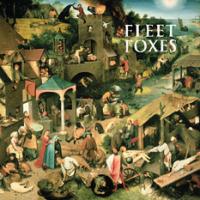Secular Hymns from Sons of the Sons of the Pioneers
The Fleet Foxes are a new band from Seattle. Put aside any associations you might have with grungy histrionics. Imagine instead a small band of Blue Ridge mountain refugees spending a good long while in remote, lush forests where they smoothed away the rough edges and filigree notes of their musical forefathers while gathering up ideas from key times (the 60’s) and places (Laurel Canyon, rural England) to create their own, incantatory sound.
The Fleet Foxes are a new band from Seattle. Put aside any associations you might have with grungy histrionics. Imagine instead a small band of Blue Ridge mountain refugees spending a good long while in remote, lush forests where they smoothed away the rough edges and filigree notes of their musical forefathers while gathering up ideas from key times (the 60’s) and places (Laurel Canyon, rural England) to create their own, incantatory sound.
This album got a lot of attention in the music press when it was released last year and it’s easy to see why. The Foxes’ music contains familiar references yet sounds like almost no one else; it’s the rare debut that arrives sounding this assured and fully formed. There’s nary a weak track in the lot.
Don’t tell the Fleet Foxes that the album format is deadthe band clearly crafted this record to work as a whole: it flows seamlessly from the beginning track, “Sun it Rises,” to the hushed conclusion of Oliver James on the flip side. There’s a processional feel to it: tempos stay measured while the emotions soar; the songs lope and trotnever breaking into a run.
The Foxes show their hand immediately on the first track: harmony and plenty of it. The band name-checks the Beach Boys in the liner notes (along with many others both expected (Neil Young, Joanna Newsom) and not (Steve Reich) but their singing is much closer in spirit and execution to Appalachian close-harmony singing. Another reference point might be the Sons of The Pioneers (!). The harmonies, story-telling-like cadences and economy of the instrumental backing are common to both, but the Foxes exchange the Sons’ mythic west for a more elusive narrative agenda but a very persuasive emotional one. These fellows have one foot in a campfire and the other in a cathedral.
Spiritual references abound on Fleet Foxes but the theological touchstone is Thoreau rather than any of the Western Big Three. The band does a good job of laying out its aspirations in the album’s liner notes:
“Music is magic to me, transportative and full of wonder in a way that I have trouble getting from the natural world… You can call it escapism if you like, but I see it as connecting to a deeper human feeling than found in the day-to-day world”.
Evocative, incantatory and quietly epic, this record fulfills the band’s stated desire to transport in spades. The economy of the performances- there are virtually no solos- and lead vocalist Robin Pecknold’s keening vocals keep preciousness at bay.
Also integral to the band’s sound is the uncredited sixth member: Max Reverb. Pecknold’s solo singing rings out in a cathedral-sized space, the entire recording floats in it. This much reverb, to my ears, usually removes the music to a hazy distance and robs performances of intimacy. Here however it works; the aural equivalent of a fog machine that gives the stage just the right aura of mystery. Whether this approach is sustainable remains to be heard.
Vinyl copies of Fleet Foxes come with the Sun Giant ep. Recorded before Fleet Foxes, Sun Giant expands slightly on the FF blueprint with additional instrumental colors, while mining the same territory.
If you spend much of your listening time with music from the halcyon days of CSNY, Fleetwood Mac (post Peter Green, pre LA), Eagles (early), Beach Boys, Van Morrison et al you can safely dip your toes into the 21st century with this record.
- Log in or register to post comments




